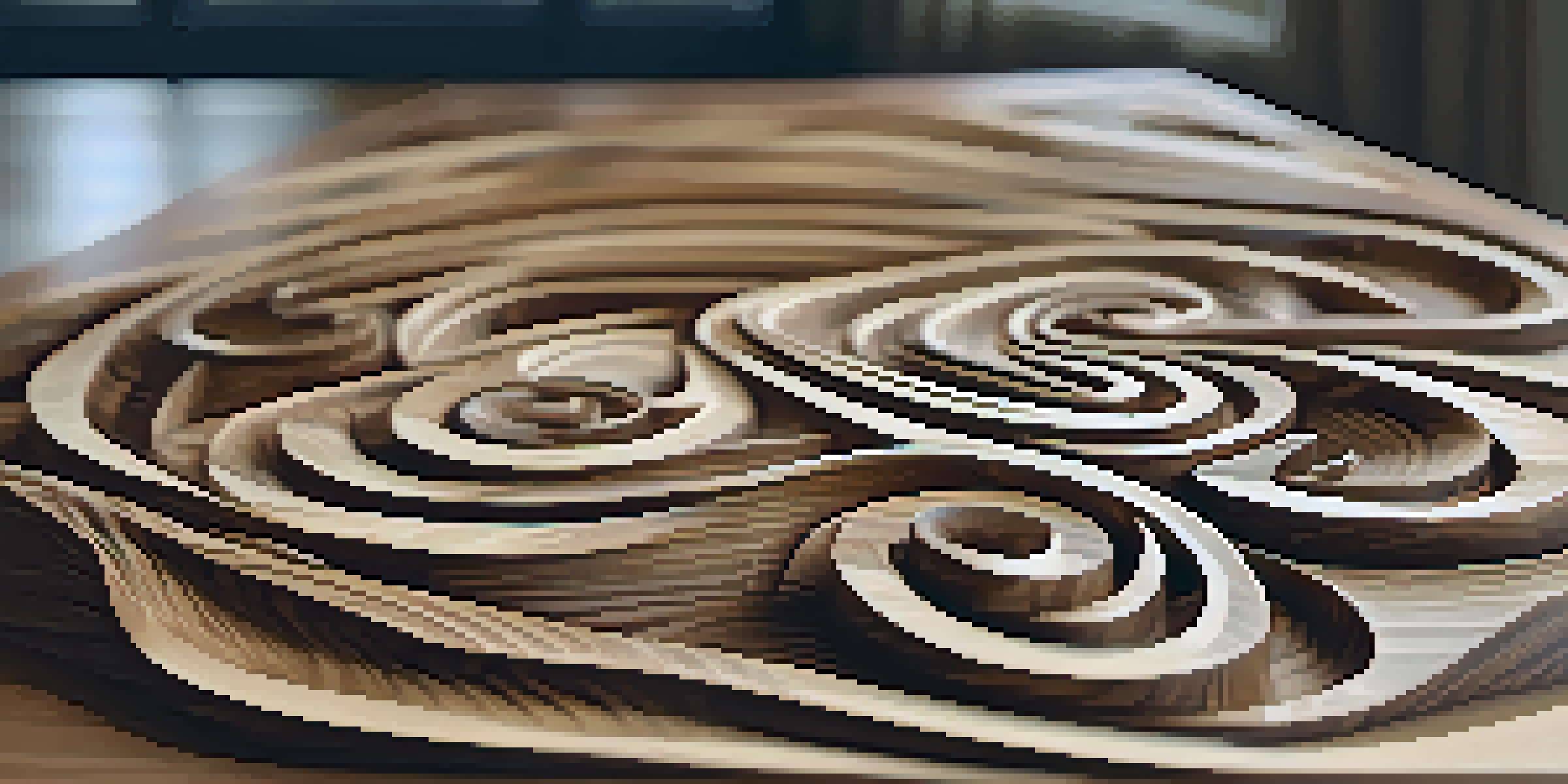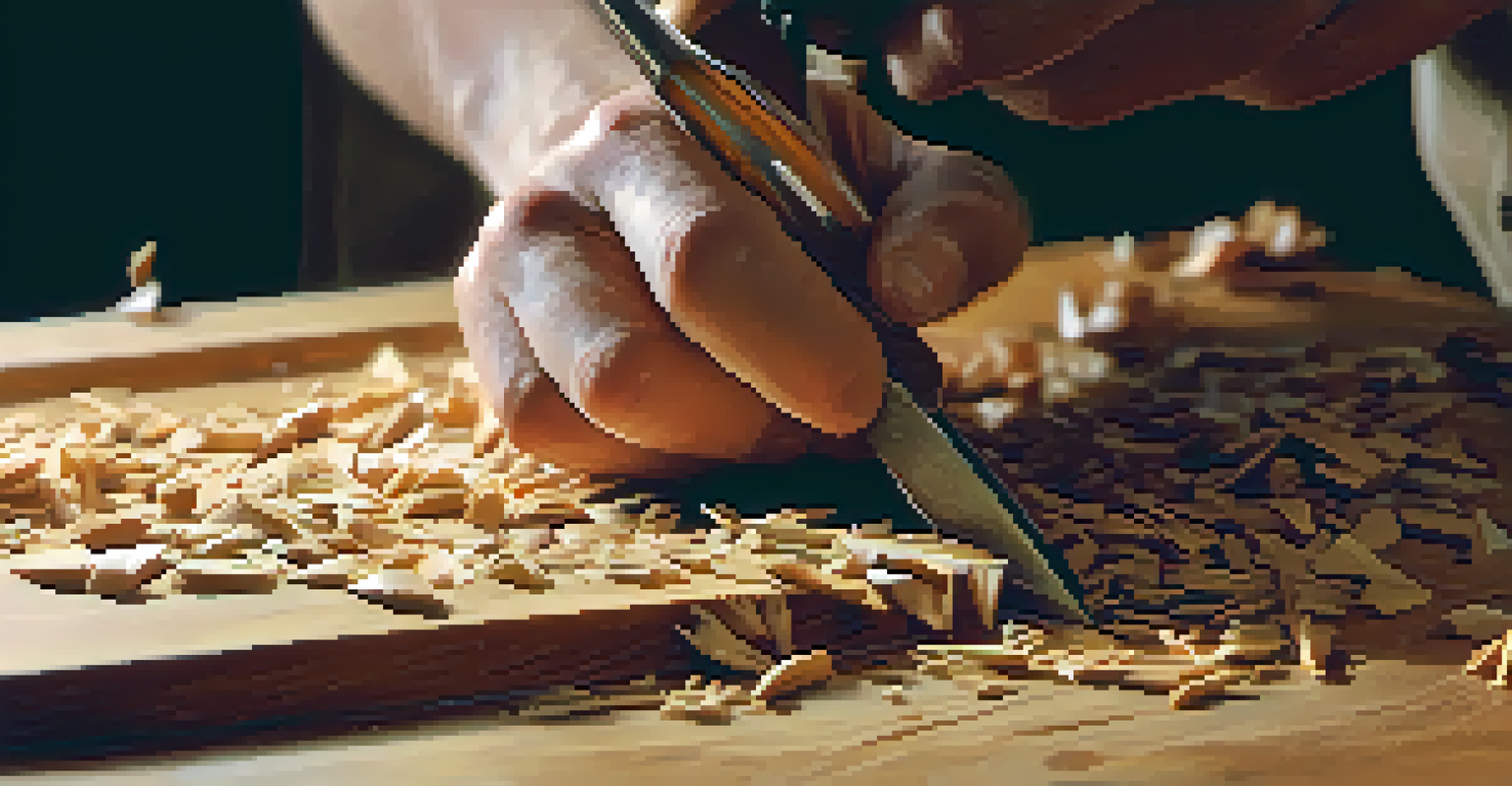Understanding Grain Direction: A Beginner's Carving Guide

What is Grain Direction in Wood?
Grain direction refers to the orientation of the wood fibers in a piece of timber. These fibers can run in various directions, and understanding them is crucial for anyone looking to carve wood. Just like strands of hair, wood fibers can flow in a specific direction, affecting how the wood responds to cutting tools.
The wood is not just a material to work with; it is a living entity that has its own grain and direction, guiding the craftsman in their art.
When you examine a piece of wood, you might notice lines or patterns running along its surface. These are the grain lines, and they can guide you on how to approach your carving. For instance, carving along the grain often results in smoother cuts, while carving against it can lead to splintering or tearing.
Recognizing grain direction can save you a lot of frustration and ensure a cleaner finish on your projects. It's one of the first things you should learn as a beginner in wood carving, as it sets the foundation for more advanced techniques.
Types of Grain Patterns You Might Encounter
Wood can exhibit various grain patterns, including straight, wavy, and curly. Straight grain is generally the easiest to work with, making it ideal for beginners. However, wavy or curly grains can add beautiful visual effects to your finished piece, though they may require more skill to carve.

For example, a piece of oak typically has a straight grain, making it predictable and user-friendly for novice carvers. On the other hand, birdseye maple features a unique pattern that can be stunning but may pose challenges due to its irregularities.
Understanding Grain Direction
Grain direction indicates the orientation of wood fibers, crucial for achieving clean cuts in wood carving.
Understanding these patterns will help you choose the right wood for your project and anticipate how it will behave during the carving process. So, take some time to explore different types of wood and their grain patterns—it's a fun way to enhance your skills!
How to Identify Grain Direction
Identifying grain direction is a straightforward yet essential skill for beginners. Start by examining the wood closely; the grain will usually run from one end of the board to the other. You can also feel the texture of the wood with your fingers to determine which way the fibers are aligned.
Working with the grain is like dancing with the rhythm of nature; it leads to harmony in the creation process.
A handy trick is to look for the end grain, which is the cross-section of the wood. This reveals the direction of the fibers and can help you visualize how they will react to carving tools. If you're ever in doubt, make a small test cut in an inconspicuous area to see how the wood behaves.
With practice, identifying grain direction will become second nature. This skill not only helps in carving but also improves your overall understanding of wood properties, making you a more versatile craftsman.
The Importance of Carving with the Grain
Carving with the grain is essential for achieving smooth, clean cuts. When you carve in the same direction as the wood fibers, you allow the tools to glide effortlessly, reducing the risk of splintering. This is especially important for beginners, as it builds confidence in your carving abilities.
For instance, when creating a curved detail, always aim to follow the natural flow of the grain. This approach not only makes the carving easier but also enhances the beauty of the final piece. You'll find that the wood responds more favorably, resulting in a more polished look.
Importance of Carving with the Grain
Carving with the grain ensures smoother cuts and enhances the visual appeal of the finished piece.
In contrast, carving against the grain can lead to frustration and uneven results. By prioritizing carving with the grain, you set yourself up for success and create a more enjoyable woodworking experience.
Common Mistakes to Avoid with Grain Direction
Even seasoned carvers can make mistakes when it comes to grain direction, but beginners are particularly prone to these pitfalls. One common error is not checking the grain before starting a cut. This oversight can lead to jagged edges and a less-than-desirable finish on your work.
Another mistake is assuming that all pieces of wood behave the same way. Each type of wood has unique characteristics, and grain direction can vary even within the same species. Always take the time to inspect your wood and adjust your techniques accordingly.
Learning from these mistakes is part of the journey, so don't be discouraged if things don't go perfectly at first. Embrace each experience as an opportunity to grow your skills and deepen your understanding of wood carving.
Tools and Techniques for Working with the Grain
Having the right tools can make all the difference when carving with the grain. Sharp chisels and carving knives are essential for clean cuts, as dull tools can tear the fibers and create a rough surface. Investing in quality tools will pay off in the long run, enabling you to achieve a professional finish.
In addition to sharp tools, consider using specific techniques to enhance your carving. For example, when making deeper cuts, start shallow and gradually increase the depth while following the grain. This technique allows for better control and reduces the risk of damaging the wood.
Avoid Common Carving Mistakes
Beginners often overlook grain direction, leading to jagged edges, so it's vital to inspect wood before carving.
Finally, practice is key. Try experimenting with various tools and techniques on scrap pieces of wood. This hands-on approach will help you understand how different tools interact with grain direction, ultimately improving your overall carving skills.
Resources for Further Learning about Grain Direction
Exploring additional resources can deepen your understanding of grain direction and wood carving. Books dedicated to woodworking often provide detailed insights into various woods, their properties, and how to work with them. Look for titles that focus on beginner techniques and practical tips.
Online platforms, such as YouTube, offer countless tutorials on wood carving. Many experienced carvers share their knowledge, demonstrating how to identify grain direction and apply it effectively. Watching these videos can provide visual context and inspire new techniques.

Joining woodworking forums or local carving clubs can also be beneficial. Engaging with a community of fellow enthusiasts allows you to ask questions, share experiences, and learn from others' successes and mistakes. The more you immerse yourself in the craft, the more confident you'll become!